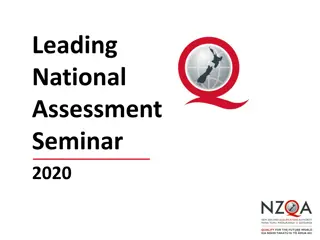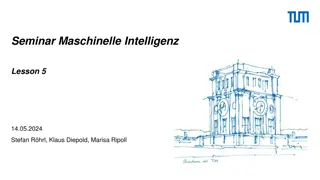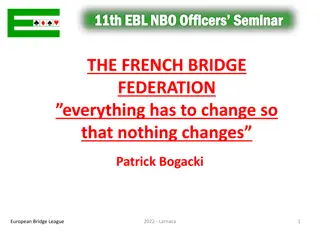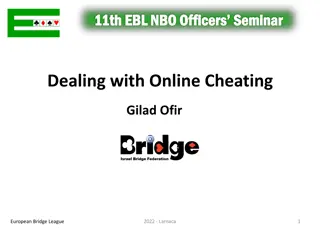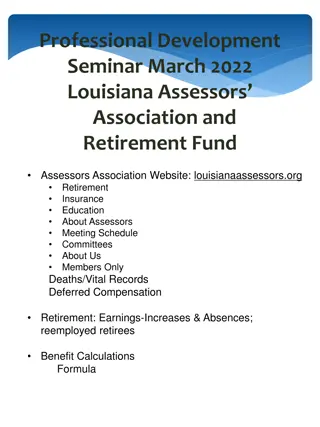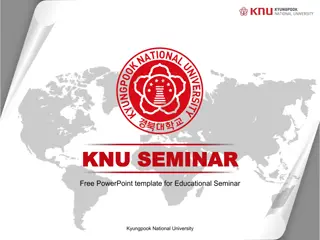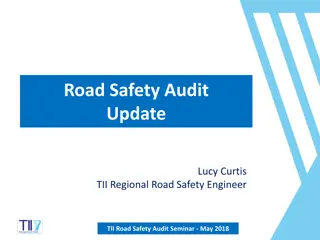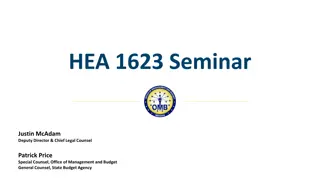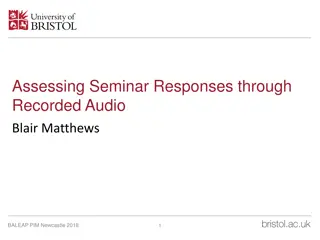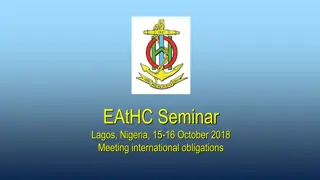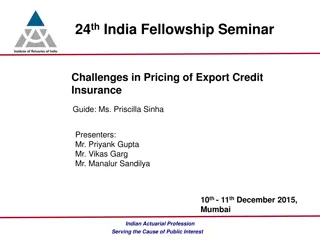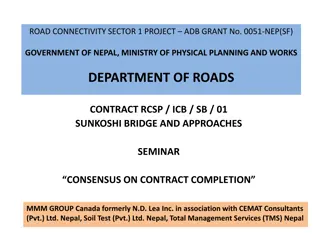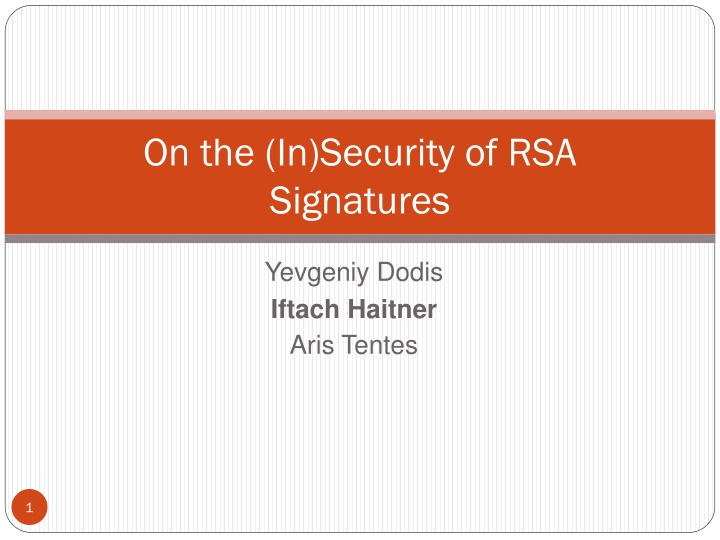
RSA Signature Security Analysis
Explore the security of RSA signatures and the challenges in RSA-FDH schemes. Discover the limitations of the Random Oracle Heuristic and the novel techniques in creating secure RSA-based signatures. Delve into the complexities of ruling out RSA-FDH without compromising its integrity.
Uploaded on | 0 Views
Download Presentation

Please find below an Image/Link to download the presentation.
The content on the website is provided AS IS for your information and personal use only. It may not be sold, licensed, or shared on other websites without obtaining consent from the author. If you encounter any issues during the download, it is possible that the publisher has removed the file from their server.
You are allowed to download the files provided on this website for personal or commercial use, subject to the condition that they are used lawfully. All files are the property of their respective owners.
The content on the website is provided AS IS for your information and personal use only. It may not be sold, licensed, or shared on other websites without obtaining consent from the author.
E N D
Presentation Transcript
On the (In)Security of RSA Signatures Yevgeniy Dodis Iftach Haitner Aris Tentes 1
Signature Schemes Triplet of efficient algorithms (Gen,Sign,Ver) Gen(1k): s,v Signs(m): Verv(m, ): 0/1 Correctness and existential unforgability Key criteria: Efficiency/Simplicity Provable security 2
RSA Full-Domain-Hash Signatures Gen(1k): s = (n= p q, d), v =(n,e) where d e-1 mod (n) Signn,d(m): h(m)d mod n Vern,e(m, ): 1 iff h(m) e mod n Where h:{0,1} Zn is a fixed hash function (e.g., SHA1) Very efficient Basis of several standards: PKCS#1 Secure (under the RSA assumption) when h is modeled as a random function (i.e., secure in the random oracle heuristic ) [Bellare-Rogaway 93] Can we reduce the security of RSA-FDH to some falsifiable assumption? 3
Known Results The Random Oracle Heuristic is not always a security guarantee [Canetti et. al, Nielsen, Goldwasser-Kalai, Bellare et. al] Only for artificial schemes No fully-black-box trapdoor permutation FDH [Dodis-Oliveira-Pietrzak 05] Does not rule out schemes that use the group structure Other impossibility results [GMR 89, Paillier 06] Only for restricted class of reductions None of the above results rules out fully-black-box RSA-FDH Exist RSA-based signature schemes that critically do not obey these restrictions [Gennaro et. al 99, Cramer-Shoup 00, Hohenberger-Waters 09] 4
Our Result No fully-black-box RSA-FDH* from any reasonable assumption (e.g., RSA is hard) Even if the hash function depends on RSA parameters Novel adaptation of Gennaro-Trevisan ``short description paradigm to Generic Groups Construction of bounded-query RSA-FDH (under the RSA assumption) * for prime verification key (i.e., e) 5
Fully-Black-Box RSA-FDH How to rule-out RSA-FDH without breaking it? Create a world in which The RSA assumption holds RSA-FDH is breakable All known (provable) techniques to create RSA-based signatures still go through In our world The RSA group is modeled as a random group isomorphic to Zn There exists a generic forger that breaks any RSA-FDH scheme All known (provable) RSA-based signatures are secure
Fully-Black-Box RSA-FDH cont. Formally, we only consider reductions that Work over any group G isomorphic to Zn and treat G as black-box (alternatively, Zn is treated as a symbolic group) The adversary (i.e., the forger) is treated as a black-box Several meaningful ways to do so [Nechaev 94, Shoup 97, Maurer 05] Our model captures all known RSA based signature schemes [Gennaro et. al 99, Cramer-Shoup 00, Hohenberger- Waters 09] Allows Oblivious Sampling
Zn (Zn ) Generic Groups -1 a b -1(a) -1(b) For n2N, let nbe the set of all permutations from Zn Zn For 2 n, let (Zn ) be the group induced by on Zn by translating the operations over (Zn ) those of Zn For a,b2 (Zn ) a-1 = (( -1(a))-1mod n) a b = ( -1(a) -1(b)mod n) Sometimes we explicitly write a b [ (Zn ) ] Let Gn = { (Zn ): 2 n} and G = {Gn: n 2 N} 8
The RSA Assumption over G For any efficient A Pr[AG(1k,n,e,x) xd[Gn]] = negl(k) G = {Gi} G (n = p q 2 (2k),e) Gen(1k) x Zn d = e-1 mod (n) Lemma ([Aggarwal Maurer 09], reproved here*) RSA assumption over G is equivalent to factoring 9
Claim: BB proof from RSA (or any hard assumption) ) Weakly BB proof Let Dk be a random RSA challenge (i.e., (n,e,y)) RG,F(n,e,y) outputs x = yd[Gn] Fully-Black-Box RSA-FDH over G G={Gi} 2 G GenG (1k): s = (n = p q, d, h()), v=(n,e,h()) d = e-1 mod (n) hG:{0,1} Zn is an efficient oracle-aided function SignGn,d,h(m): hG(m)d [Gn] VerGn,e(m, ) : 1 iff hG(m) e [Gn] AlgorithmFbreaks (Gen,Sign,Ver), if PrG G [FGbreak the unforgability of (GenG,SignG,VerG)] > neg(k) Black box proof from RSA: 9 9 efficientR, F breaks the scheme ) RF breaks the RSA assumption over G F gives us extra power (recall that RSA is hard over G ) Weakly black-box proof: 9 9 efficient R and D = {Dk} F breaks the scheme ) for any efficient Emul, |(Dk,RG,F(1k,Dk))G G, (Dk ,EmulG (1k,Dk))G G| > neg(k)
Impossibility of RSA-FDH Theorem: There exists no RSA-FDH with weakly black-box proof Main Lemma: There exist (inefficient) F and efficient Emul such that for any RSA-FDH (with Pr[e2P] > negl) 1. F breaks the scheme 2. |(Dk ,RG,F(1k,Dk), (Dk ,EmulG,R (1k,Dk))|< 2-k for any efficient R and any D={Dk}, where G G 11
The Forger F Incorrect!, for instance h(i) = 2efor all i 0, h(0) = y h(i) = (2e)i for all i 0, h(0) = y Either such degenerate queries are detectable given q and thus we change F to returns ? still strong enough to break RSA-FDH Or imply a factoring of n and thus easy to emulate FG(n,e,h,x1, ,xt) If |h|<t, and 8 8i2[t] hG(i) xie [Gn] Compute (say by factoring n) d e-1 mod (n) and return (hG(0))d [Gn] Otherwise, return ? ? ? on such queries It suffices to prove that 1. FGbreaks the security of any RSA-FDH 2. For all (non-uniform) efficient R, Pr[q RG(1k): FG (q) ?] = negl(k) On FG query, Emul returns ? ? On FG query, Emul either factors or returns ? ? Pr[q RG(1k): FG(q) ?& q is non-degenerate]= negl(k) 12
Pr[FG(q) ?&q= (n,e,h,{xi})non-degenerate]= negl Proof idea: The only way to know h(i)d is to hardwire h(i)=xe Since q is non-degenerate, the h(i) s are unrelated Since |h|< t, h can only contain < t unrelated hardwired values The actual proof follows Gennaro-Trevisan paradigm: [Gennaro-Trevisan 00, Gennaro et. al 05, Haitner et. al 07, ] Rcontradicts claim ) ) too short description for 2 n All previous works are in the random functions realm 13
Short Description of Let Gn = (Zn ) and let q=(n,e,q,{xi}i2[t]) = RG(1k) Description: for some W Zn of size t (desc. of) h, -1(Zn \ W) + (short) advice Reconstruction: 1. Use h + advise to emulate (HG;RG) and find W 2. Use the collisions {xie h(i)} + advice to compute -1(W) Since |h| < t, the above description is too short Compressor / Decompressor might be unbounded 8 8i eval hG(i) b = a-1 f = c g 8 8ievalxie Output q Does such set W always exist? Yes for non-degenerate q What are non-degenerate queries? [Dodis et. al]: (essentially) h(i) h(j) Here, need to also worry about algebraic relations HG Zn Zn W -1(W) RG 14
Hardwired Values Hardwire values: first appear on the right-hand side It is hard to find non-degenerate relations between them We assume there are t hardwire values {wi}i2[t],and let W={wi} {h(i) xie}i2[t]) ) { wijmij wije m ij [Gn]}i2[t] ) ) { -1(wijmij) -1(wij) e m ij [Zn ]} i2[t] Let MH= {mij} and MH;R= {m ij} Non degenerated MH ) )h + -1(Zn \{wi}) + (short) advise determine -1({wi}) 8 8 i eval hG(i) b = a-1 f = c g 8 8 i eval xie 15
The Collision Matrix MH Recall { wijmij wije m ij}, MH= {mij} , MH;R= {m ij} Claim 1: ranke (MH)< t ) )forging is easy (using e2 P) e.g., h(1) = w1, h(2) = w15) We modify FG to return ? ? on such h In the following we assume ranke (MH)= t and let a = det(MH - e MH;R) 0 Claim 2:gcd(a, (n)) is large large contains all prime factors of (n) of size (log n)! (1) ) ) factoring n is easy ) ) Emulating the call FG(n,e,h,{xi}) is easy Claim 3: gcd(a, (n)) is not large not large ) ) -1({wi}) is determined by h, -1(Zn \{wi}) and a short advice () ) short description of ) Since does not have a short description ) ) Over Generic Groups, RSA factoring ) x2 = x15 (via [Miller 76]) 16
Solution Set for = (-1(w1),,-1(wt)) Assume that (HG;RG) has k steps, and for i2{0, ,k} let Si be the solution set for after the i th step |S0|= (n)t 2. |Si+1| divides |Si| 3. Let p2 2Pbe a factor of (n) but not then |Sk| ( (n)/p)t Proof : since { -1(wijmij) -1(wij e m ij) [Zn ]} Fix super-polynomial such p(recall gcd(a, (n)) is not large) The emulation of (HG;RG) determines Sk ) )h, -1(Zn \ {wi}) and the index of inside Skdetermine ) shorter description of (in t log(p) -h| 2 2 (t) bits) 1. not of a = det(MH e MH;R), 17 )
Emulating (HG;RG) Basic idea: keep an order list of the query answers (log n for each) and remove (the preimages of) these elements from -1(Zn \{wi}) Problem: How to handle collisions? Should give enough information to enable the emulation Should not give redundant information Solution: just give the necessary information about Problem: now our description of equals its (real) length! Solution: describe each informative collision using O(log log n) bits |S0|= (n)t |Si+1| divides |Si| |Sk| ( (n)/p)t Hence, 9 {i1,..,iz} [k] s.t |Sij|/|Sij+1| pt 1. 8 8 i eval hG(i) b = a-1 f = c g 8 8i eval xie 2. f b 3. 18
Open Questions Rule out Black-box RSA-FDH for any e (also non primes) Rule out constructions of RSA-FDH with black-box proof Use Gennaro-Trevisan paradigm to obtain other Generic Groups impossibility results: e.g., BLS signatures and RSA-OAEP 19

